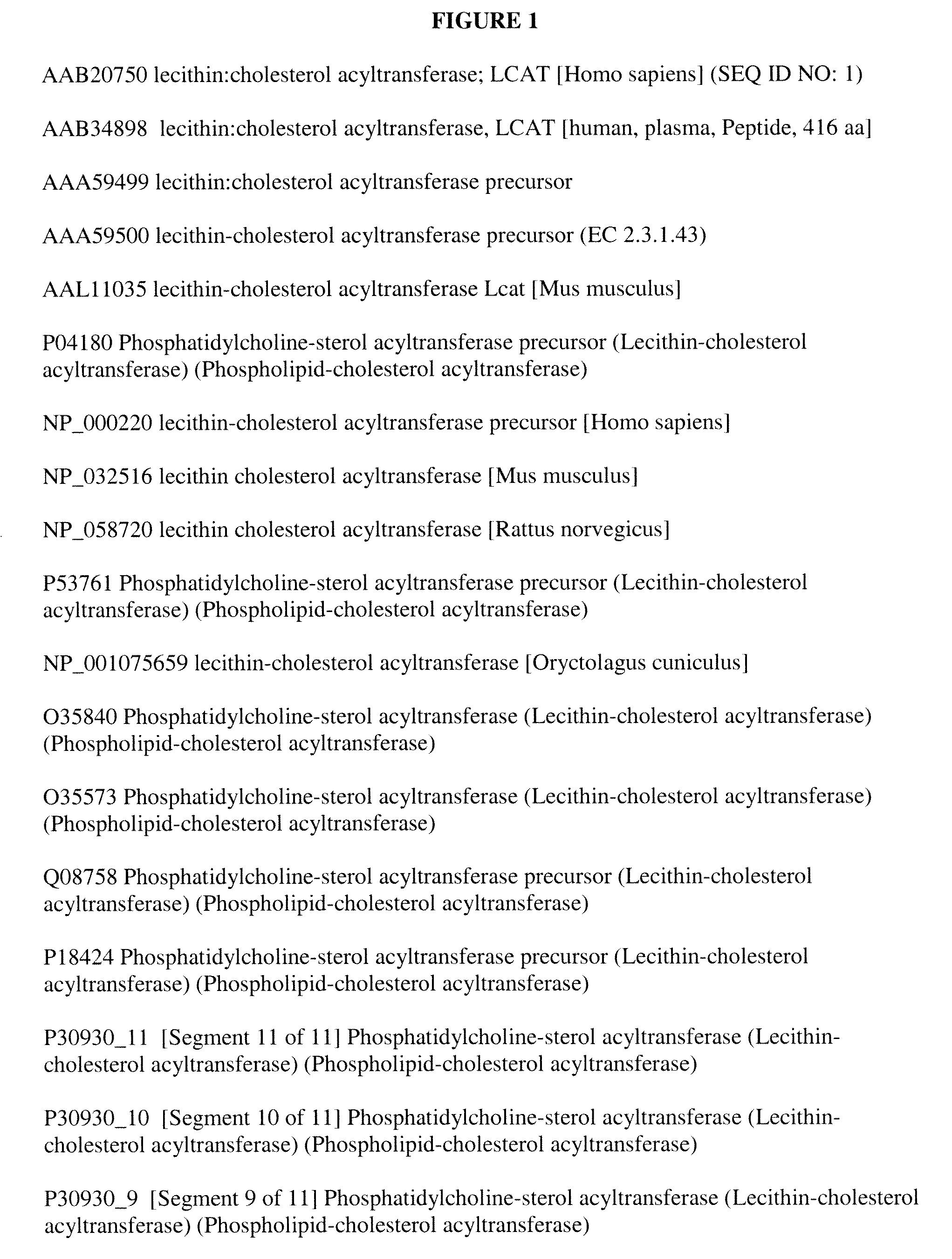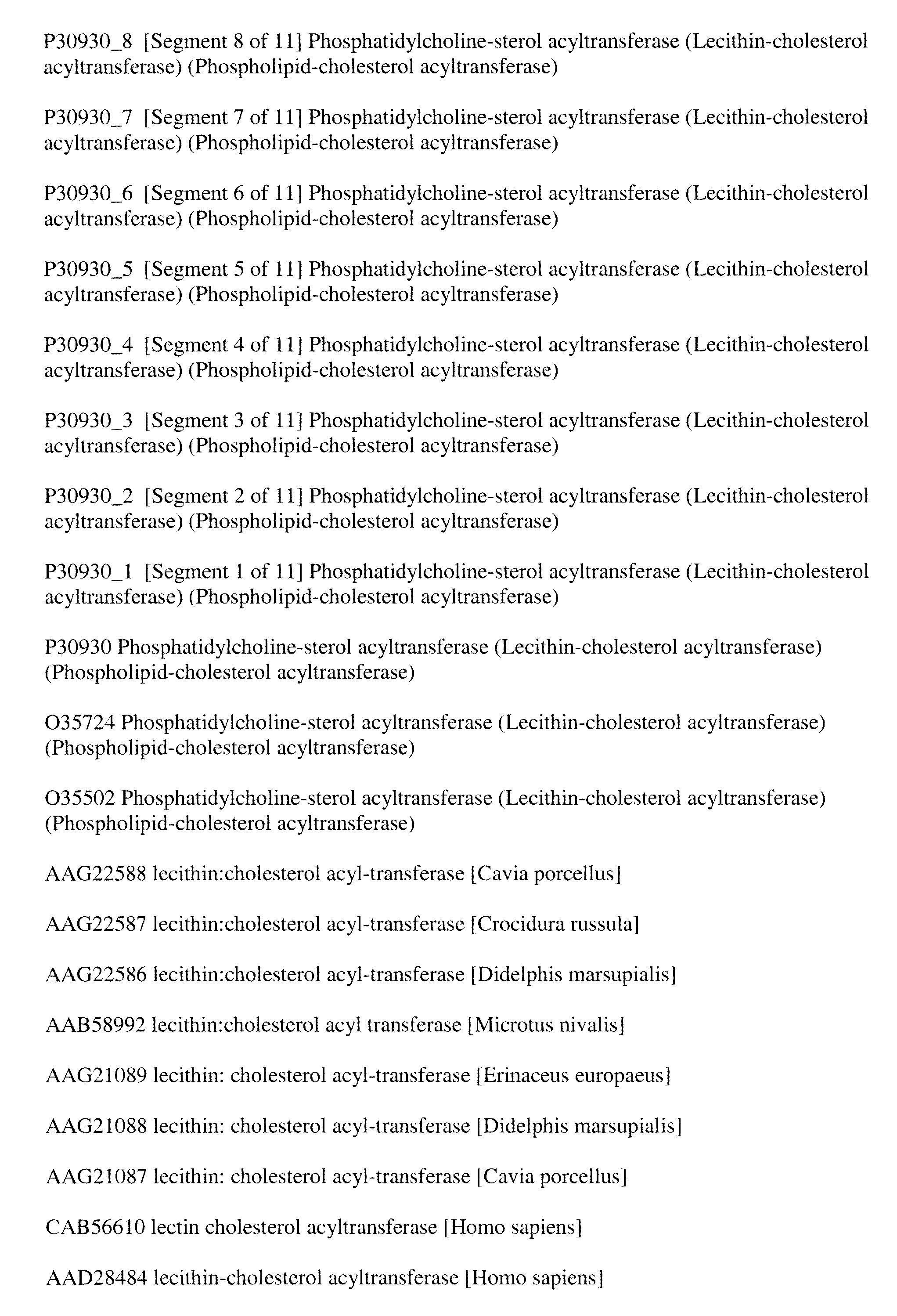Modified Lecithin-Cholesterol Acyltransferase Enzymes
- Summary
- Abstract
- Description
- Claims
- Application Information
AI Technical Summary
Benefits of technology
Problems solved by technology
Method used
Image
Examples
example 1
Preparation of Modified LCAT Protein
[0235]A polynucleotide encoding wild type human LCAT protein (SEQ ID NO: 1) was cloned from human liver cDNA library. DNA encoding the wild type human LCAT protein was mutagenized using Quickchange site-directed mutagenesis kit (Stratagene) well known and routinely utilized in the art.
[0236]Briefly, primer pairs containing the designed mutations were incorporated into the newly synthesized DNA molecules. The newly synthesized LCAT coding sequence was tagged with a polynucleotide encoding human Fc fragment at the C-terminus of the encoded protein. The parental template was digested with Dpn I endonuclease. The nicked vector DNA containing the desired mutants was transformed into XL1-Blue E. coli. Plasmids encoding mutant LCAT were recovered from the transformed E. coli. The presence of the mutations in the plasmids was confirmed by DNA sequencing analysis and the mutant LCAT-Fc constructs were transfected into CHO cells for protein expression using...
example 2
Screens for Modified LCAT Proteins
[0238]LCAT Enzyme Activity
[0239]Activity of the modified LCAT proteins was determined by measuring the change of the rate of conversion of 3H-labeled cholesterol (FC) to cholesteryl ester (CE). In the plasma LCAT activity assay (CER), human plasma samples were equilibrated with a trace amount of radiolabeled cholesterol at 4° C. and the rate of cholesterol esterification was measured by thin layer chromatography (TLC) analysis after incubation at 37° C. (Dobiasova and Frohlich, Physiol Res. 1996; 45, 65-73).
[0240]For measuring compound activity using apoAI-liposome assay format, modified LCAT protein was expressed in CHO cells and enzyme secreted from the stably transfected cells was harvested in the serum-free culture medium. The activity of the modified LCAT enzyme in the culture media was determined using apoAI-liposome substrates prepared by the standard cholate-dialysis procedure (Chen et al. (1982) J. Lipid Res. 23: 680-691). The initial mixtu...
example 3
Recombinant LCAT Protein with Double Mutations
[0251]In view of the activity measurements observed above with various LCAT mutations, a number of double mutants comprising a C31Y substitution and an additional substitution, as shown below, were prepared and assessed for activity by the ability to convert of radiolabeled cholesterol (FC) into cholesteryl ester (CE), as described before.
[0252]Results are shown below in Table 4 with the double mutants compared to wild-type protein and the single mutant C31Y LCAT protein. As used in Table 4, “−” indicates enzyme activity was below the detection level; “+” is shown as the wild-type LCAT protein activity; “++” indicates enzyme activity was in the range of −20% to +50% of wild-type protein activity; “+++” indicates activity in the range of +100% to +500% of wild-type protein activity; and “++++” indicates enzyme activity greater than +500% of wild-type LCAT activity.
TABLE 4LCAT ProteinLCAT activity (nmol / h / μg)Wild-type+C31Y+++C31Y, F1S+++C3...
PUM
| Property | Measurement | Unit |
|---|---|---|
| Pressure | aaaaa | aaaaa |
| Composition | aaaaa | aaaaa |
| Length | aaaaa | aaaaa |
Abstract
Description
Claims
Application Information
 Login to View More
Login to View More - R&D
- Intellectual Property
- Life Sciences
- Materials
- Tech Scout
- Unparalleled Data Quality
- Higher Quality Content
- 60% Fewer Hallucinations
Browse by: Latest US Patents, China's latest patents, Technical Efficacy Thesaurus, Application Domain, Technology Topic, Popular Technical Reports.
© 2025 PatSnap. All rights reserved.Legal|Privacy policy|Modern Slavery Act Transparency Statement|Sitemap|About US| Contact US: help@patsnap.com



